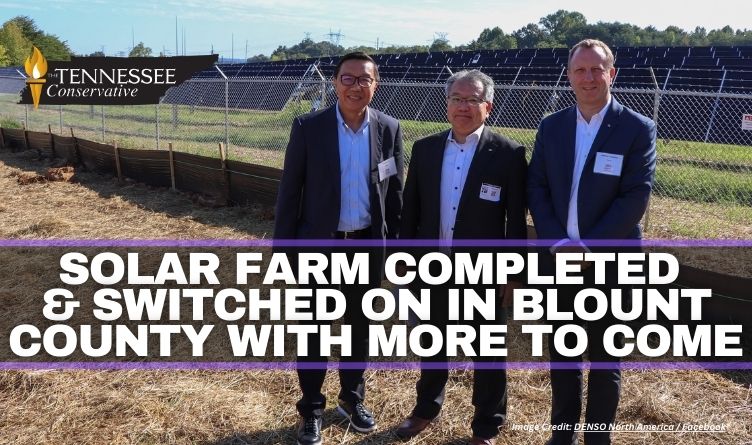Image Credit: DENSO North America / Facebook
The Tennessee Conservative [By Paula Gomes] –
Construction of one of three solar farms has been completed and operations have commenced in Maryville, Tennessee.
DENSO Manufacturing Tennessee, Inc. (DMTN), who partnered with the City of Maryville, the Tennessee Valley Authority (TVA), and Nashville renewable energy company Silicon Ranch, hosted a ceremony to “flip the switch” on the nearly 13-acre project which will help support the local power grid while also producing “green” energy for DMTN’s operations.
Partners in the project broke ground on the solar farm over two years ago, with construction on the project wrapping up over the summer. The facility is expected to produce around 3,400 MWh/year through the use of over 4,000 solar panels.

Two more solar farms are planned for Blount County with the second expected to be completed by December. The final farm is projected to be up and running sometime between April and June of 2026. When all three are finished, DMTN hopes to source all of the company’s electrical needs via renewable energy.
Through participating in a TVA program, DMTN also plans to source solar energy from another Silicon Ranch facility in the Tennessee Valley.
TVA’s Green Invest program targets the business and industry sectors looking to meet sustainability goals.
DMTN has operated in Maryville for 35 years and aims to be “carbon neutral” in ten years time. The company has its global headquarters in Kariya, Japan.
The 47.9 billion mobility supplier manufactures electrification, powertrain, thermal, and mobility electronic products for almost every vehicle that exists.
Chuntao Ye, President of DMTN and Business Leader of the DENSO North America Peace of Mind Business Group, thanked all project partners for sharing the same commitment to be “green” in East Tennessee and said that DMTN looks forward to continuing to work with all parties in working to advance renewable energy.
Ray Knotts, TVA Senior Director of Demand Management, said that working with community partners like DMTN aligns with TVA’s mission to provide low-cost energy to the Valley region that is reliable.
“Flipping this switch in partnership with DENSO, the City of Maryville, an Silicon Ranch helps TVA meet growing electricity demand and diversifies our portfolio,” said Knotts.
Silicon Ranch, a market leader in the field, pioneered utility-scale solar in the region and has worked with TVA and more than 50 local power companies since 2011. The company is the owner and operator of one of the largest fleets of solar facilities in the United States.
Matt Beasley, Silicon Ranch Chief Commercial Officer, believes the project, and others like it, will help the strength, health, and resiliency of communities.
“Silicon Ranch takes great pride in our Tennessee roots,” said Beasely.

The leader of the development work in the city is a seventh generation native of Maryville.
Maryville Mayor Andy White said that the partnership between the city, TVA, DMTN, and Silicon Ranch “highlights our commitment to a cleaner, more sustainable future” and stated that the project would provide affordable service to its 30,000 residents as well as the 4,000 businesses and industries in the area.
TVA – the largest public power supplier in the United States – delivers energy to more than ten million across seven states in the southeast and has one of the most diverse energy systems which includes gas, hydro, nuclear, and solar technologies.
A corporate agency of the U.S., TVA receives no taxpayer funding, instead getting almost all of its revenues from the sale of electricity. TVA’s retail rates are currently lower than eighty percent of the rest of the U.S. Its industrial rates are lower than ninety-five percent of the top utilities, and in addition, TVA also provides land management for the Tennessee River system, flood control, and navigation.
Last month, the U.S. Department of Agriculture announced that they will no longer subsidize large-scale solar projects placed on farmland or use solar panels that have been manufactured by foreign adversaries.
Since 2022, hundreds of billions of taxpayer dollars have gone toward projects of this type.
According to Agricultural Economic Insights, nearly half of utility-scale projects are located on farmland. The presence of solar panels on American farmland has increased by almost fifty percent over the last thirteen years.
Tennessee has lost more than 1.2 million acres of farmland over the last three decades.

About the Author: Paula Gomes is a Tennessee resident and reporter for The Tennessee Conservative. You can reach Paula at paula@tennesseeconservativenews.com.



8 Responses
These solar farms are horrible for wildlife and the ecosystem. I previously lived only about 10 miles from one and everything was dying around them, not to mention what an eyesore they are.
.
OK if sun shines, useless when not. Denso was Nippondenso.
This is ridiculous, we know from other solar farms in America, it causes grid instability and many other negative problems. If they survive hail storms, which has not been the case so far, Extensive Land Use and Habitat Disruption, Resource Demands and Waste Management are prevalent and they are UGLY.
https://biologyinsights.com/why-solar-farms-are-bad-a-scientific-perspective/
https://www.renewableenergyworld.com/solar/utility-scale/texas-hailstorm-damages-thousands-of-solar-panels-at-350-mw-farm/
I believe the reason for this uptick in these eye sores is the Data centers are sucking up our water and electricity, while the people pay for it, until there is no more water to be had. Wake Up Tennesseans.
And where did the solar panels come from?? Without explicit documentation, it’s not confirmed whether the solar panels for the Maryville, Blount County solar farms were sourced from China, or the USA. hmmm why is that???
Chinese-made solar panels (besides not made in USA) have a significantly higher cradle-to-grave carbon footprint (80-250 g CO2eq/kWh) compared to U.S.-made panels (40-60 g CO2eq/kWh), primarily due to China’s reliance on coal-powered manufacturing and transportation emissions. U.S. panels benefit from a cleaner energy mix and shorter supply chains, resulting in a shorter carbon payback period. (For more precise figures, I need more transparent data from Chinese manufacturers BUT it’s doubtful it would show any environmental impact concerns.) The life expectancy of Chinese and U.S.-made solar panels is broadly similar, with 25-30 years as the standard for high-quality panels from both regions. U.S. panels may have a slight edge in longevity (up to 30-40 years for premium brands) due to lower degradation rates (0.4-0.6% vs. 0.6-0.8% per year) and stricter quality control. U.S. manufacturers often adhere to stricter quality and environmental standards, which can enhance durability. For example, SunPower panels are known for low degradation rates (0.4-0.6% per year), contributing to longer effective lifespans, potentially exceeding 30 years. Chinese-made solar panels, produced by major manufacturers like Jinko Solar, Longi, Trina Solar, and JA Solar, typically have a lifespan of 25-30 years, aligning with global standards.
The people of TN need to wake up to what the TVA is doing in this state: it is not to benefit the state or its residents. Solar farms are really bad: they are toxic when panels are breached and the chemicals enter nd destroy the soil; they cook birds in flight; they do not generate enough energy (OE., they are money laundering schemes) and will plunge the countries affected into rolling brown/blackouts and create chaos. Solar farms are the reason California has so much power and fire issues. In Nevada and CA, wild life is being decimated. The residents of these counties need to be given an opportunity to voice objections to the planting of these eyesores and environmental hazards before the land is sold. TVA is not your friend.
Stupid and useless. The TVA responsibilities and who oversees it need to be totally revamped. They seem to answer to no one but the climate extremists/activists. Hope President Trump cuts off the spigot completely for solar like he is doing for wind.
It seems these solar projects are going up everywhere and we don’t know about it until it’s done. Trying to find out is like a shell game. I was driving north toward Millington, TN the other day and saw cleared land with short metal stakes sticking out of the ground for as far as I could see. I’ve never seen a construction site that looked like that before. My conclusion was it must be a solar farm. After searching the internet, “I think” that’s exactly what it is although, information is sketchy & misleading. Trying to find up to date info is hard. I think it’s the Graceland Solar Facility that will be generating 150 megawatts on 1,500 acres of what used to be farmland. “Search Assist” says…..”The project is currently in the permitting stage, with construction expected to begin in 2026 and commercial operation anticipated in 2027.” It looked to me like construction is going full blast at this very moment. Bear in mind, Millington already has a 53 megawatts farm. And get this, the 150-megawatt solar facility will allocate 100 megawatts to Meta for use at its data center in Gallatin…. which happens to be 200 miles away. Far as I can tell, RWE is building it and selling the power. So Gallatin will be using 2/3’s of the power generated in Millington. The rest will go to MLG&W. Go figure. Why not the other way around? BTW, RWE AG is a German multinational energy company headquartered in Essen, Germany.
I love how nuking 13 acres and putting a bunch of panels is greener than growing plants which naturally sequester carbon and provide many wildlife benefits, like food, habitat, and soil improvement. These people are actually destroying environment they pretend to want to save while burning billions that could have been used to help people. I actually like solar, I mean it makes some sense on a rooftop which is normally wasted space, if it helps supplement the buildings power, and provide protection to the underlying roof.